Final Accounts: Sole Traders & Partnerships Report - Semester 1
VerifiedAdded on 2021/01/02
|17
|4534
|124
Report
AI Summary
This report provides a detailed analysis of final accounts for sole traders and partnerships. It covers the reasons for preparing final accounts, the process and limitations of preparing them, and methods for constructing accounts from incomplete records. The report explains the causes of imbalances resulting from incorrect entries and incomplete records. It delves into the calculation of opening and closing capital, cash/bank accounts, and the preparation of sales and purchase ledger control accounts, along with the concepts of markups and margins. The report outlines the components of final accounts, including the statement of profit and loss and the statement of financial position. It also explores the key components of partnership agreements and accounts, the preparation of the profit and loss appropriation account, and the allocation of profits to partners, including capital and current accounts. Finally, the report covers the calculation of closing balances for each partner's capital and current accounts and the presentation of the statement of financial position.
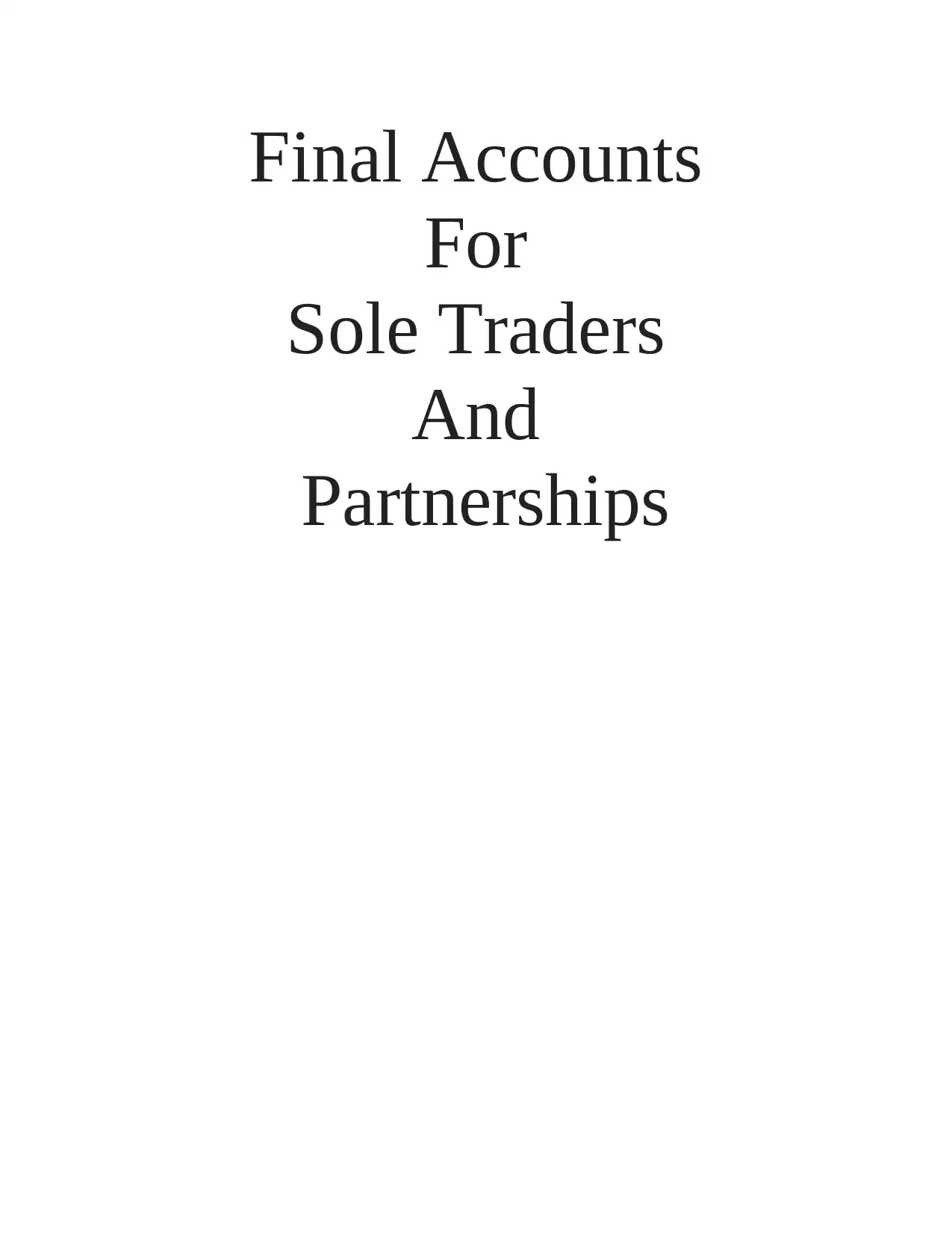
Final Accounts
For
Sole Traders
And
Partnerships
For
Sole Traders
And
Partnerships
Paraphrase This Document
Need a fresh take? Get an instant paraphrase of this document with our AI Paraphraser
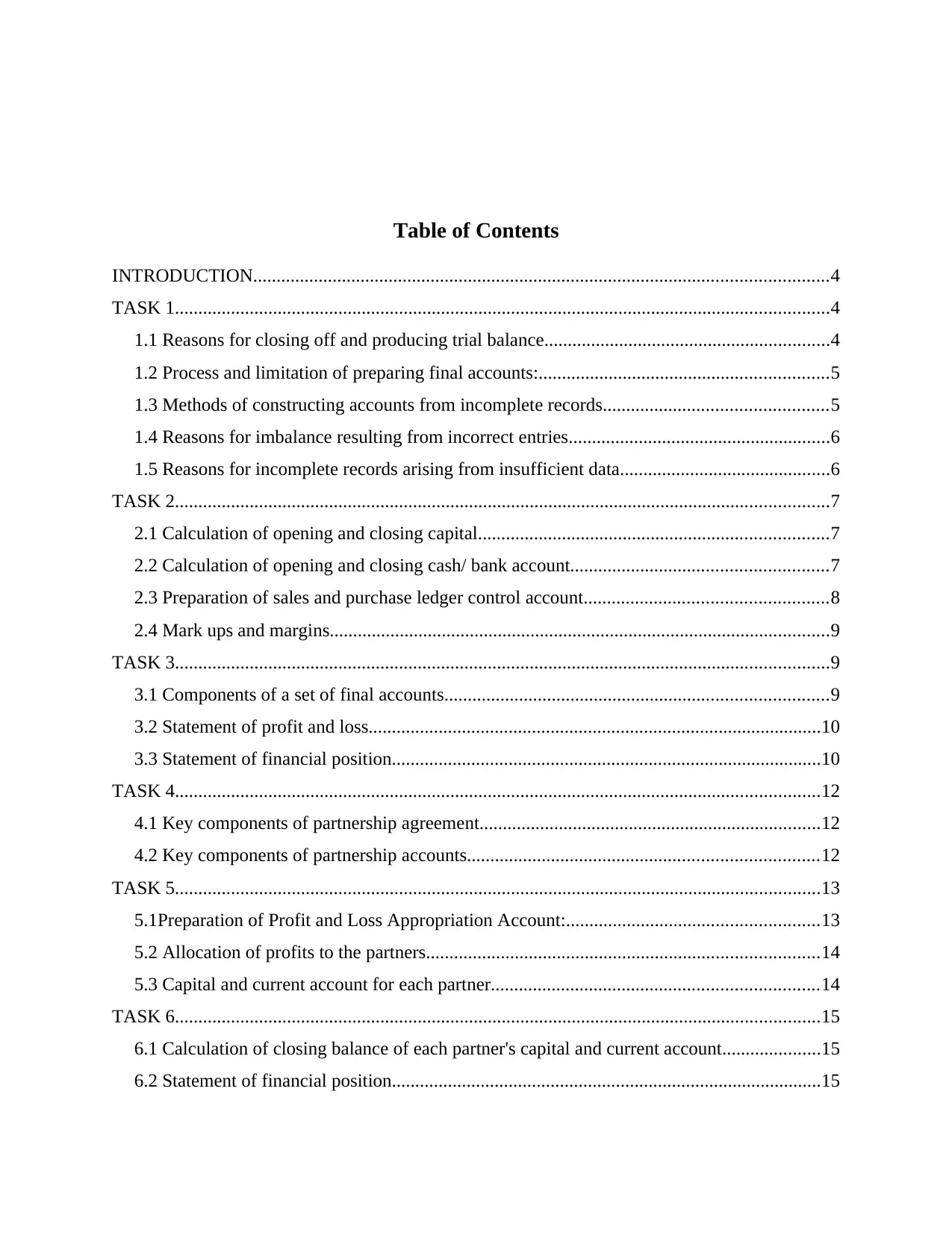
Table of Contents
INTRODUCTION...........................................................................................................................4
TASK 1............................................................................................................................................4
1.1 Reasons for closing off and producing trial balance.............................................................4
1.2 Process and limitation of preparing final accounts:..............................................................5
1.3 Methods of constructing accounts from incomplete records................................................5
1.4 Reasons for imbalance resulting from incorrect entries........................................................6
1.5 Reasons for incomplete records arising from insufficient data.............................................6
TASK 2............................................................................................................................................7
2.1 Calculation of opening and closing capital...........................................................................7
2.2 Calculation of opening and closing cash/ bank account.......................................................7
2.3 Preparation of sales and purchase ledger control account....................................................8
2.4 Mark ups and margins...........................................................................................................9
TASK 3............................................................................................................................................9
3.1 Components of a set of final accounts..................................................................................9
3.2 Statement of profit and loss.................................................................................................10
3.3 Statement of financial position............................................................................................10
TASK 4..........................................................................................................................................12
4.1 Key components of partnership agreement.........................................................................12
4.2 Key components of partnership accounts...........................................................................12
TASK 5..........................................................................................................................................13
5.1Preparation of Profit and Loss Appropriation Account:......................................................13
5.2 Allocation of profits to the partners....................................................................................14
5.3 Capital and current account for each partner......................................................................14
TASK 6..........................................................................................................................................15
6.1 Calculation of closing balance of each partner's capital and current account.....................15
6.2 Statement of financial position............................................................................................15
INTRODUCTION...........................................................................................................................4
TASK 1............................................................................................................................................4
1.1 Reasons for closing off and producing trial balance.............................................................4
1.2 Process and limitation of preparing final accounts:..............................................................5
1.3 Methods of constructing accounts from incomplete records................................................5
1.4 Reasons for imbalance resulting from incorrect entries........................................................6
1.5 Reasons for incomplete records arising from insufficient data.............................................6
TASK 2............................................................................................................................................7
2.1 Calculation of opening and closing capital...........................................................................7
2.2 Calculation of opening and closing cash/ bank account.......................................................7
2.3 Preparation of sales and purchase ledger control account....................................................8
2.4 Mark ups and margins...........................................................................................................9
TASK 3............................................................................................................................................9
3.1 Components of a set of final accounts..................................................................................9
3.2 Statement of profit and loss.................................................................................................10
3.3 Statement of financial position............................................................................................10
TASK 4..........................................................................................................................................12
4.1 Key components of partnership agreement.........................................................................12
4.2 Key components of partnership accounts...........................................................................12
TASK 5..........................................................................................................................................13
5.1Preparation of Profit and Loss Appropriation Account:......................................................13
5.2 Allocation of profits to the partners....................................................................................14
5.3 Capital and current account for each partner......................................................................14
TASK 6..........................................................................................................................................15
6.1 Calculation of closing balance of each partner's capital and current account.....................15
6.2 Statement of financial position............................................................................................15
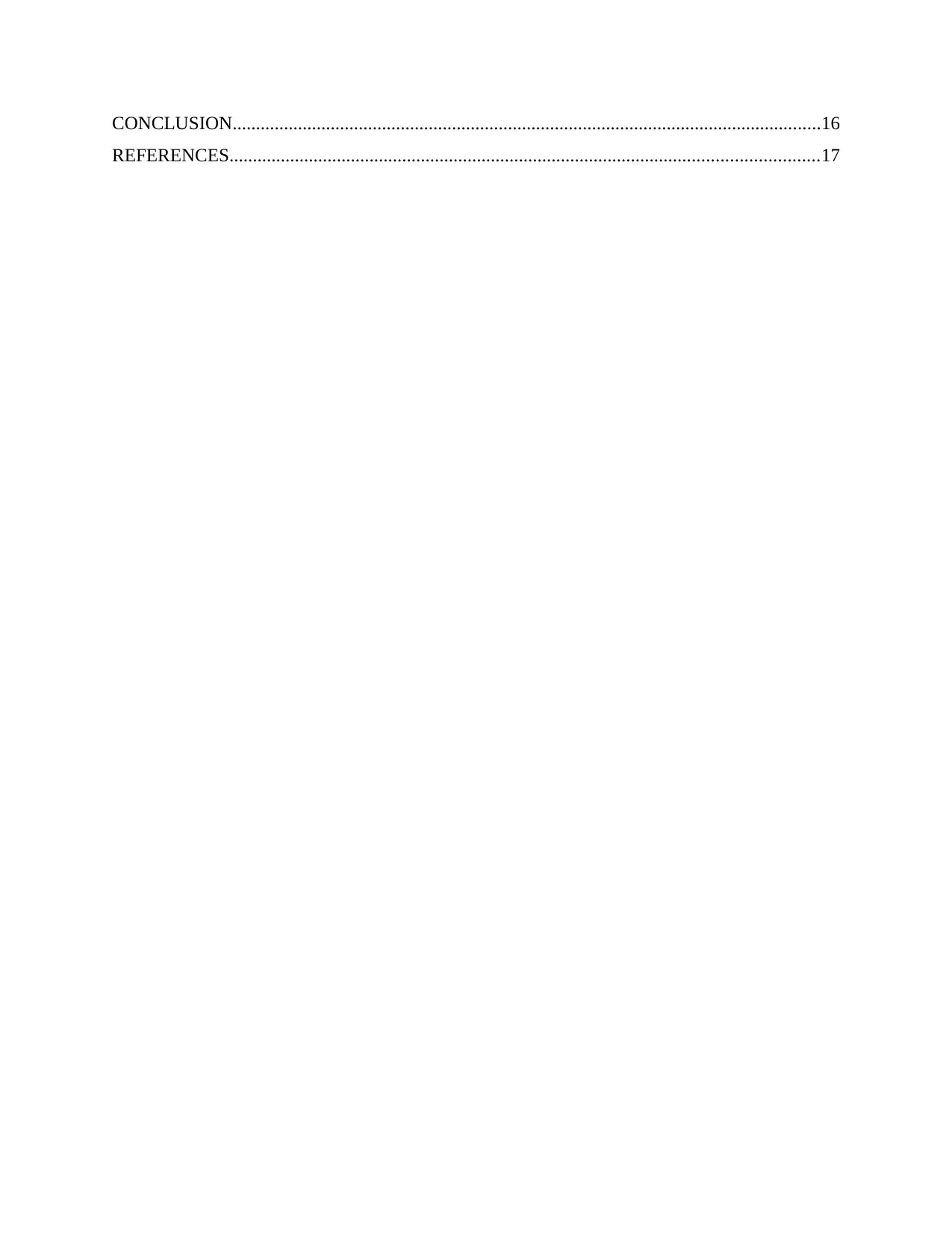
CONCLUSION..............................................................................................................................16
REFERENCES..............................................................................................................................17
REFERENCES..............................................................................................................................17
⊘ This is a preview!⊘
Do you want full access?
Subscribe today to unlock all pages.

Trusted by 1+ million students worldwide
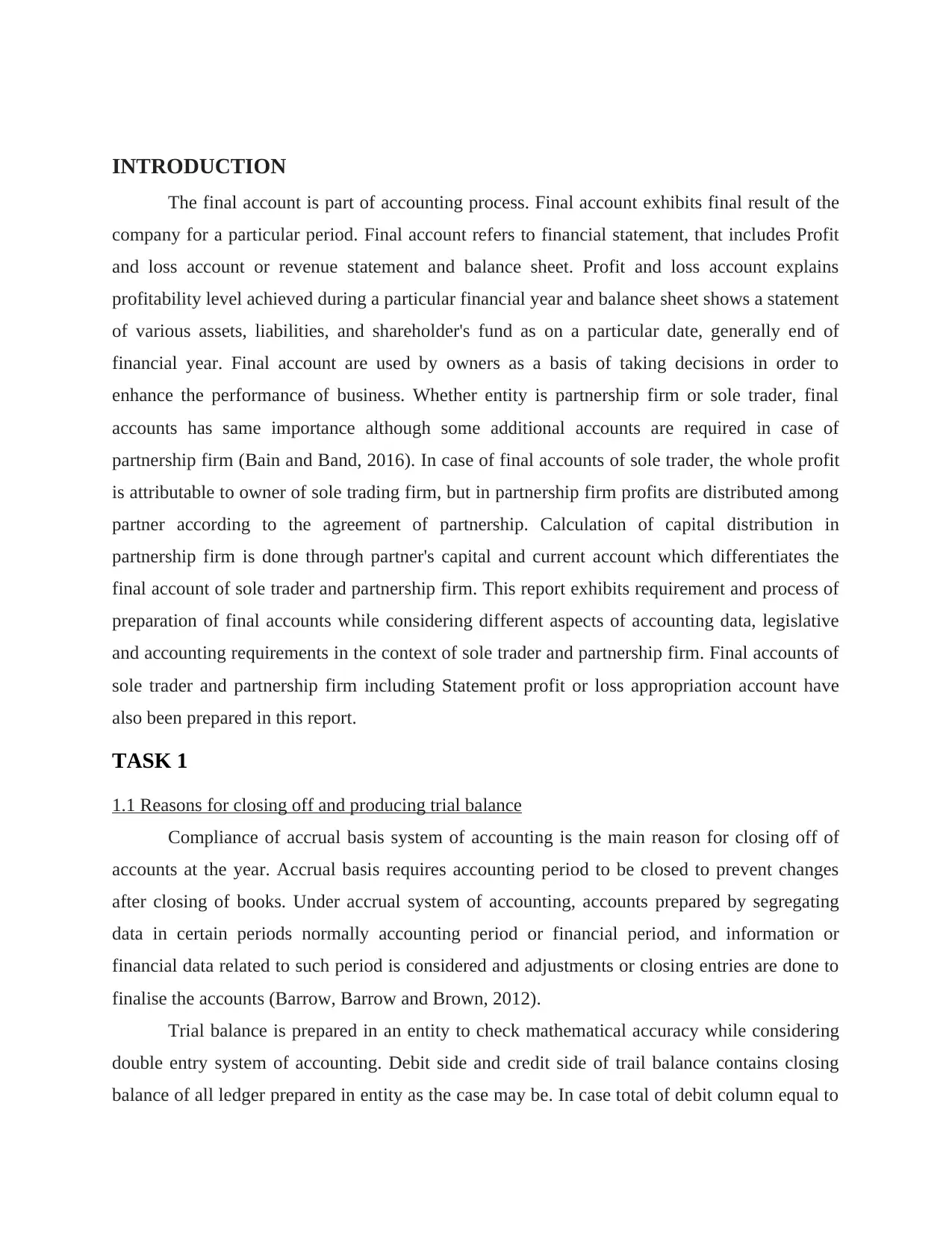
INTRODUCTION
The final account is part of accounting process. Final account exhibits final result of the
company for a particular period. Final account refers to financial statement, that includes Profit
and loss account or revenue statement and balance sheet. Profit and loss account explains
profitability level achieved during a particular financial year and balance sheet shows a statement
of various assets, liabilities, and shareholder's fund as on a particular date, generally end of
financial year. Final account are used by owners as a basis of taking decisions in order to
enhance the performance of business. Whether entity is partnership firm or sole trader, final
accounts has same importance although some additional accounts are required in case of
partnership firm (Bain and Band, 2016). In case of final accounts of sole trader, the whole profit
is attributable to owner of sole trading firm, but in partnership firm profits are distributed among
partner according to the agreement of partnership. Calculation of capital distribution in
partnership firm is done through partner's capital and current account which differentiates the
final account of sole trader and partnership firm. This report exhibits requirement and process of
preparation of final accounts while considering different aspects of accounting data, legislative
and accounting requirements in the context of sole trader and partnership firm. Final accounts of
sole trader and partnership firm including Statement profit or loss appropriation account have
also been prepared in this report.
TASK 1
1.1 Reasons for closing off and producing trial balance
Compliance of accrual basis system of accounting is the main reason for closing off of
accounts at the year. Accrual basis requires accounting period to be closed to prevent changes
after closing of books. Under accrual system of accounting, accounts prepared by segregating
data in certain periods normally accounting period or financial period, and information or
financial data related to such period is considered and adjustments or closing entries are done to
finalise the accounts (Barrow, Barrow and Brown, 2012).
Trial balance is prepared in an entity to check mathematical accuracy while considering
double entry system of accounting. Debit side and credit side of trail balance contains closing
balance of all ledger prepared in entity as the case may be. In case total of debit column equal to
The final account is part of accounting process. Final account exhibits final result of the
company for a particular period. Final account refers to financial statement, that includes Profit
and loss account or revenue statement and balance sheet. Profit and loss account explains
profitability level achieved during a particular financial year and balance sheet shows a statement
of various assets, liabilities, and shareholder's fund as on a particular date, generally end of
financial year. Final account are used by owners as a basis of taking decisions in order to
enhance the performance of business. Whether entity is partnership firm or sole trader, final
accounts has same importance although some additional accounts are required in case of
partnership firm (Bain and Band, 2016). In case of final accounts of sole trader, the whole profit
is attributable to owner of sole trading firm, but in partnership firm profits are distributed among
partner according to the agreement of partnership. Calculation of capital distribution in
partnership firm is done through partner's capital and current account which differentiates the
final account of sole trader and partnership firm. This report exhibits requirement and process of
preparation of final accounts while considering different aspects of accounting data, legislative
and accounting requirements in the context of sole trader and partnership firm. Final accounts of
sole trader and partnership firm including Statement profit or loss appropriation account have
also been prepared in this report.
TASK 1
1.1 Reasons for closing off and producing trial balance
Compliance of accrual basis system of accounting is the main reason for closing off of
accounts at the year. Accrual basis requires accounting period to be closed to prevent changes
after closing of books. Under accrual system of accounting, accounts prepared by segregating
data in certain periods normally accounting period or financial period, and information or
financial data related to such period is considered and adjustments or closing entries are done to
finalise the accounts (Barrow, Barrow and Brown, 2012).
Trial balance is prepared in an entity to check mathematical accuracy while considering
double entry system of accounting. Debit side and credit side of trail balance contains closing
balance of all ledger prepared in entity as the case may be. In case total of debit column equal to
Paraphrase This Document
Need a fresh take? Get an instant paraphrase of this document with our AI Paraphraser
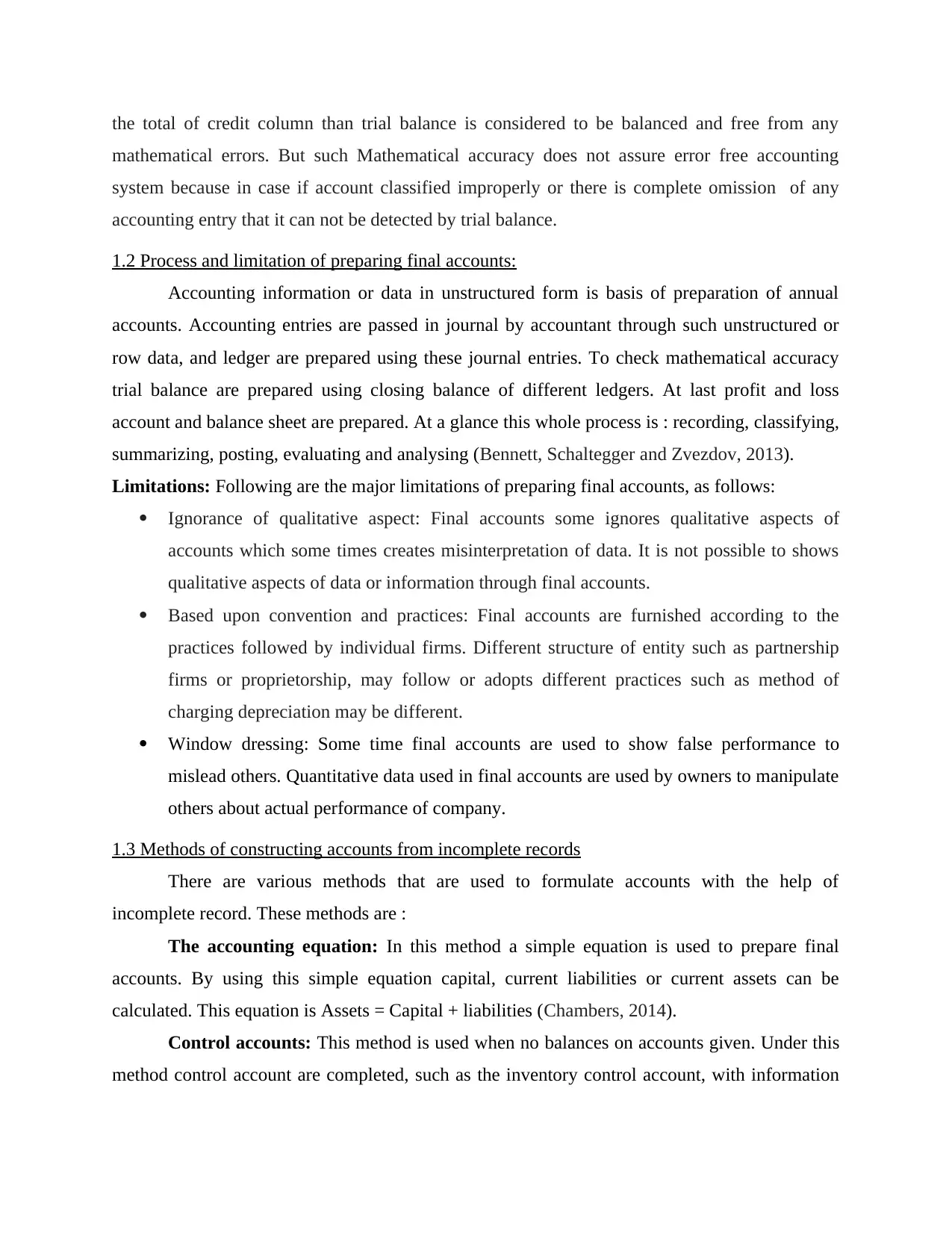
the total of credit column than trial balance is considered to be balanced and free from any
mathematical errors. But such Mathematical accuracy does not assure error free accounting
system because in case if account classified improperly or there is complete omission of any
accounting entry that it can not be detected by trial balance.
1.2 Process and limitation of preparing final accounts:
Accounting information or data in unstructured form is basis of preparation of annual
accounts. Accounting entries are passed in journal by accountant through such unstructured or
row data, and ledger are prepared using these journal entries. To check mathematical accuracy
trial balance are prepared using closing balance of different ledgers. At last profit and loss
account and balance sheet are prepared. At a glance this whole process is : recording, classifying,
summarizing, posting, evaluating and analysing (Bennett, Schaltegger and Zvezdov, 2013).
Limitations: Following are the major limitations of preparing final accounts, as follows:
Ignorance of qualitative aspect: Final accounts some ignores qualitative aspects of
accounts which some times creates misinterpretation of data. It is not possible to shows
qualitative aspects of data or information through final accounts.
Based upon convention and practices: Final accounts are furnished according to the
practices followed by individual firms. Different structure of entity such as partnership
firms or proprietorship, may follow or adopts different practices such as method of
charging depreciation may be different.
Window dressing: Some time final accounts are used to show false performance to
mislead others. Quantitative data used in final accounts are used by owners to manipulate
others about actual performance of company.
1.3 Methods of constructing accounts from incomplete records
There are various methods that are used to formulate accounts with the help of
incomplete record. These methods are :
The accounting equation: In this method a simple equation is used to prepare final
accounts. By using this simple equation capital, current liabilities or current assets can be
calculated. This equation is Assets = Capital + liabilities (Chambers, 2014).
Control accounts: This method is used when no balances on accounts given. Under this
method control account are completed, such as the inventory control account, with information
mathematical errors. But such Mathematical accuracy does not assure error free accounting
system because in case if account classified improperly or there is complete omission of any
accounting entry that it can not be detected by trial balance.
1.2 Process and limitation of preparing final accounts:
Accounting information or data in unstructured form is basis of preparation of annual
accounts. Accounting entries are passed in journal by accountant through such unstructured or
row data, and ledger are prepared using these journal entries. To check mathematical accuracy
trial balance are prepared using closing balance of different ledgers. At last profit and loss
account and balance sheet are prepared. At a glance this whole process is : recording, classifying,
summarizing, posting, evaluating and analysing (Bennett, Schaltegger and Zvezdov, 2013).
Limitations: Following are the major limitations of preparing final accounts, as follows:
Ignorance of qualitative aspect: Final accounts some ignores qualitative aspects of
accounts which some times creates misinterpretation of data. It is not possible to shows
qualitative aspects of data or information through final accounts.
Based upon convention and practices: Final accounts are furnished according to the
practices followed by individual firms. Different structure of entity such as partnership
firms or proprietorship, may follow or adopts different practices such as method of
charging depreciation may be different.
Window dressing: Some time final accounts are used to show false performance to
mislead others. Quantitative data used in final accounts are used by owners to manipulate
others about actual performance of company.
1.3 Methods of constructing accounts from incomplete records
There are various methods that are used to formulate accounts with the help of
incomplete record. These methods are :
The accounting equation: In this method a simple equation is used to prepare final
accounts. By using this simple equation capital, current liabilities or current assets can be
calculated. This equation is Assets = Capital + liabilities (Chambers, 2014).
Control accounts: This method is used when no balances on accounts given. Under this
method control account are completed, such as the inventory control account, with information
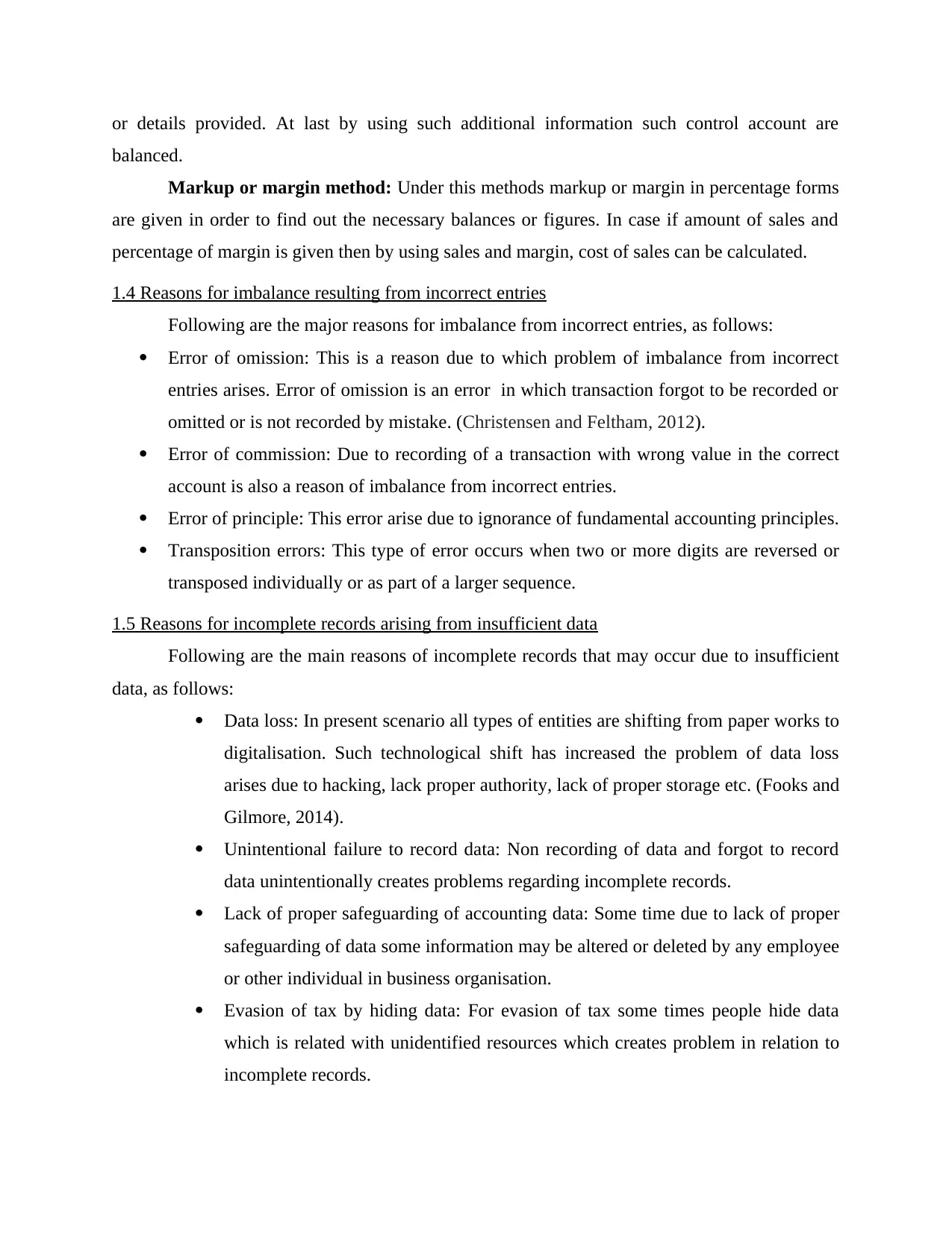
or details provided. At last by using such additional information such control account are
balanced.
Markup or margin method: Under this methods markup or margin in percentage forms
are given in order to find out the necessary balances or figures. In case if amount of sales and
percentage of margin is given then by using sales and margin, cost of sales can be calculated.
1.4 Reasons for imbalance resulting from incorrect entries
Following are the major reasons for imbalance from incorrect entries, as follows:
Error of omission: This is a reason due to which problem of imbalance from incorrect
entries arises. Error of omission is an error in which transaction forgot to be recorded or
omitted or is not recorded by mistake. (Christensen and Feltham, 2012).
Error of commission: Due to recording of a transaction with wrong value in the correct
account is also a reason of imbalance from incorrect entries.
Error of principle: This error arise due to ignorance of fundamental accounting principles.
Transposition errors: This type of error occurs when two or more digits are reversed or
transposed individually or as part of a larger sequence.
1.5 Reasons for incomplete records arising from insufficient data
Following are the main reasons of incomplete records that may occur due to insufficient
data, as follows:
Data loss: In present scenario all types of entities are shifting from paper works to
digitalisation. Such technological shift has increased the problem of data loss
arises due to hacking, lack proper authority, lack of proper storage etc. (Fooks and
Gilmore, 2014).
Unintentional failure to record data: Non recording of data and forgot to record
data unintentionally creates problems regarding incomplete records.
Lack of proper safeguarding of accounting data: Some time due to lack of proper
safeguarding of data some information may be altered or deleted by any employee
or other individual in business organisation.
Evasion of tax by hiding data: For evasion of tax some times people hide data
which is related with unidentified resources which creates problem in relation to
incomplete records.
balanced.
Markup or margin method: Under this methods markup or margin in percentage forms
are given in order to find out the necessary balances or figures. In case if amount of sales and
percentage of margin is given then by using sales and margin, cost of sales can be calculated.
1.4 Reasons for imbalance resulting from incorrect entries
Following are the major reasons for imbalance from incorrect entries, as follows:
Error of omission: This is a reason due to which problem of imbalance from incorrect
entries arises. Error of omission is an error in which transaction forgot to be recorded or
omitted or is not recorded by mistake. (Christensen and Feltham, 2012).
Error of commission: Due to recording of a transaction with wrong value in the correct
account is also a reason of imbalance from incorrect entries.
Error of principle: This error arise due to ignorance of fundamental accounting principles.
Transposition errors: This type of error occurs when two or more digits are reversed or
transposed individually or as part of a larger sequence.
1.5 Reasons for incomplete records arising from insufficient data
Following are the main reasons of incomplete records that may occur due to insufficient
data, as follows:
Data loss: In present scenario all types of entities are shifting from paper works to
digitalisation. Such technological shift has increased the problem of data loss
arises due to hacking, lack proper authority, lack of proper storage etc. (Fooks and
Gilmore, 2014).
Unintentional failure to record data: Non recording of data and forgot to record
data unintentionally creates problems regarding incomplete records.
Lack of proper safeguarding of accounting data: Some time due to lack of proper
safeguarding of data some information may be altered or deleted by any employee
or other individual in business organisation.
Evasion of tax by hiding data: For evasion of tax some times people hide data
which is related with unidentified resources which creates problem in relation to
incomplete records.
⊘ This is a preview!⊘
Do you want full access?
Subscribe today to unlock all pages.

Trusted by 1+ million students worldwide
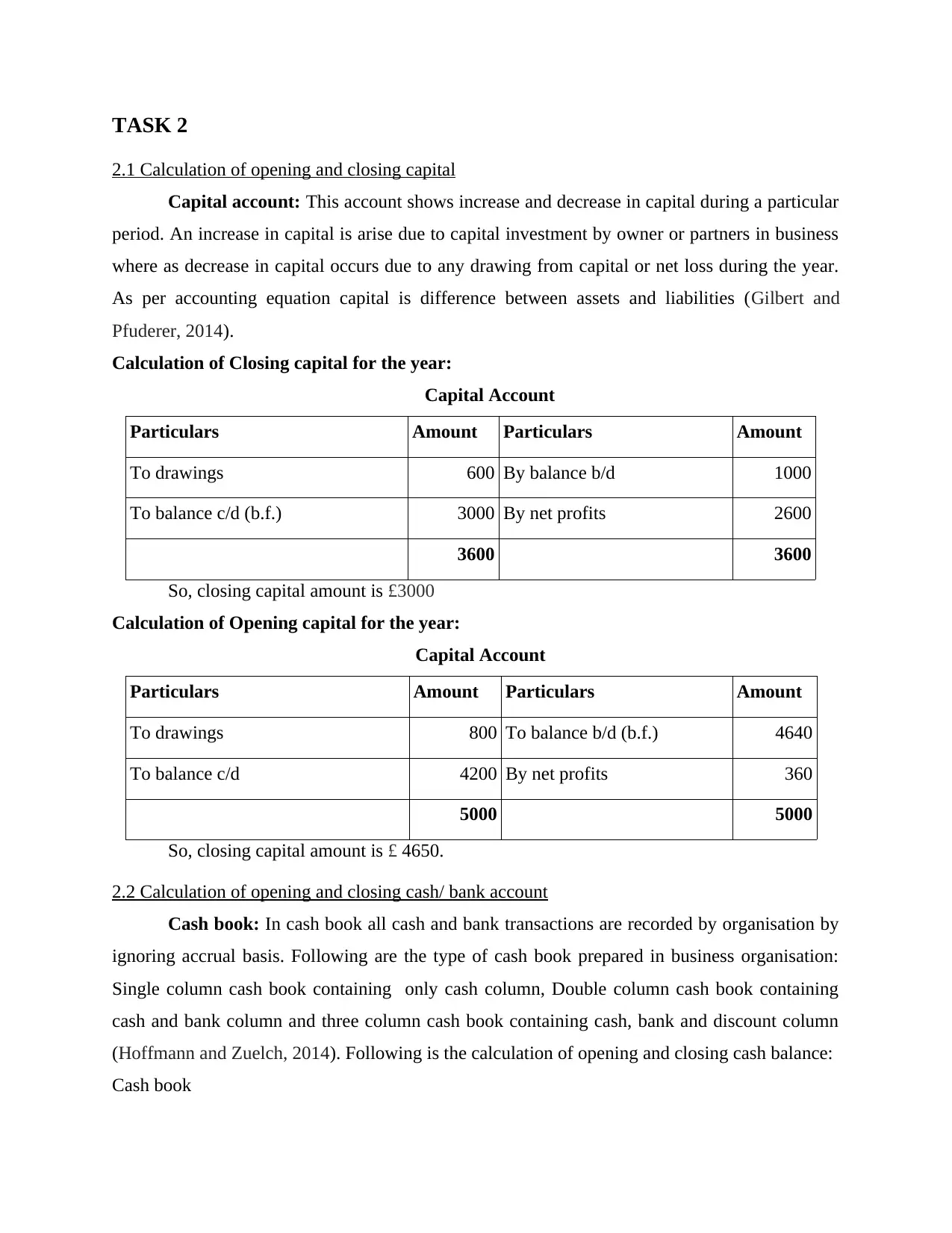
TASK 2
2.1 Calculation of opening and closing capital
Capital account: This account shows increase and decrease in capital during a particular
period. An increase in capital is arise due to capital investment by owner or partners in business
where as decrease in capital occurs due to any drawing from capital or net loss during the year.
As per accounting equation capital is difference between assets and liabilities (Gilbert and
Pfuderer, 2014).
Calculation of Closing capital for the year:
Capital Account
Particulars Amount Particulars Amount
To drawings 600 By balance b/d 1000
To balance c/d (b.f.) 3000 By net profits 2600
3600 3600
So, closing capital amount is £3000
Calculation of Opening capital for the year:
Capital Account
Particulars Amount Particulars Amount
To drawings 800 To balance b/d (b.f.) 4640
To balance c/d 4200 By net profits 360
5000 5000
So, closing capital amount is £ 4650.
2.2 Calculation of opening and closing cash/ bank account
Cash book: In cash book all cash and bank transactions are recorded by organisation by
ignoring accrual basis. Following are the type of cash book prepared in business organisation:
Single column cash book containing only cash column, Double column cash book containing
cash and bank column and three column cash book containing cash, bank and discount column
(Hoffmann and Zuelch, 2014). Following is the calculation of opening and closing cash balance:
Cash book
2.1 Calculation of opening and closing capital
Capital account: This account shows increase and decrease in capital during a particular
period. An increase in capital is arise due to capital investment by owner or partners in business
where as decrease in capital occurs due to any drawing from capital or net loss during the year.
As per accounting equation capital is difference between assets and liabilities (Gilbert and
Pfuderer, 2014).
Calculation of Closing capital for the year:
Capital Account
Particulars Amount Particulars Amount
To drawings 600 By balance b/d 1000
To balance c/d (b.f.) 3000 By net profits 2600
3600 3600
So, closing capital amount is £3000
Calculation of Opening capital for the year:
Capital Account
Particulars Amount Particulars Amount
To drawings 800 To balance b/d (b.f.) 4640
To balance c/d 4200 By net profits 360
5000 5000
So, closing capital amount is £ 4650.
2.2 Calculation of opening and closing cash/ bank account
Cash book: In cash book all cash and bank transactions are recorded by organisation by
ignoring accrual basis. Following are the type of cash book prepared in business organisation:
Single column cash book containing only cash column, Double column cash book containing
cash and bank column and three column cash book containing cash, bank and discount column
(Hoffmann and Zuelch, 2014). Following is the calculation of opening and closing cash balance:
Cash book
Paraphrase This Document
Need a fresh take? Get an instant paraphrase of this document with our AI Paraphraser
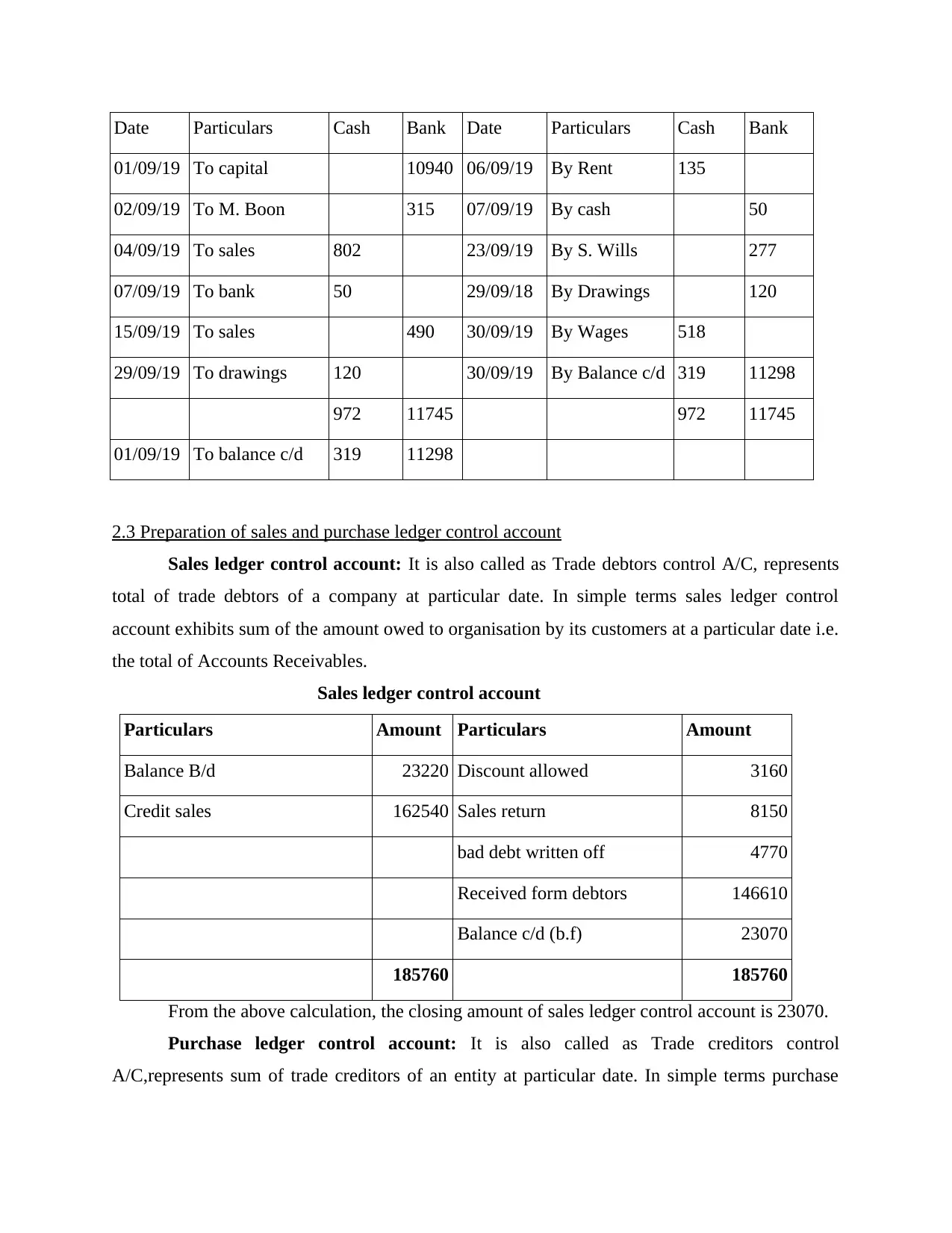
Date Particulars Cash Bank Date Particulars Cash Bank
01/09/19 To capital 10940 06/09/19 By Rent 135
02/09/19 To M. Boon 315 07/09/19 By cash 50
04/09/19 To sales 802 23/09/19 By S. Wills 277
07/09/19 To bank 50 29/09/18 By Drawings 120
15/09/19 To sales 490 30/09/19 By Wages 518
29/09/19 To drawings 120 30/09/19 By Balance c/d 319 11298
972 11745 972 11745
01/09/19 To balance c/d 319 11298
2.3 Preparation of sales and purchase ledger control account
Sales ledger control account: It is also called as Trade debtors control A/C, represents
total of trade debtors of a company at particular date. In simple terms sales ledger control
account exhibits sum of the amount owed to organisation by its customers at a particular date i.e.
the total of Accounts Receivables.
Sales ledger control account
Particulars Amount Particulars Amount
Balance B/d 23220 Discount allowed 3160
Credit sales 162540 Sales return 8150
bad debt written off 4770
Received form debtors 146610
Balance c/d (b.f) 23070
185760 185760
From the above calculation, the closing amount of sales ledger control account is 23070.
Purchase ledger control account: It is also called as Trade creditors control
A/C,represents sum of trade creditors of an entity at particular date. In simple terms purchase
01/09/19 To capital 10940 06/09/19 By Rent 135
02/09/19 To M. Boon 315 07/09/19 By cash 50
04/09/19 To sales 802 23/09/19 By S. Wills 277
07/09/19 To bank 50 29/09/18 By Drawings 120
15/09/19 To sales 490 30/09/19 By Wages 518
29/09/19 To drawings 120 30/09/19 By Balance c/d 319 11298
972 11745 972 11745
01/09/19 To balance c/d 319 11298
2.3 Preparation of sales and purchase ledger control account
Sales ledger control account: It is also called as Trade debtors control A/C, represents
total of trade debtors of a company at particular date. In simple terms sales ledger control
account exhibits sum of the amount owed to organisation by its customers at a particular date i.e.
the total of Accounts Receivables.
Sales ledger control account
Particulars Amount Particulars Amount
Balance B/d 23220 Discount allowed 3160
Credit sales 162540 Sales return 8150
bad debt written off 4770
Received form debtors 146610
Balance c/d (b.f) 23070
185760 185760
From the above calculation, the closing amount of sales ledger control account is 23070.
Purchase ledger control account: It is also called as Trade creditors control
A/C,represents sum of trade creditors of an entity at particular date. In simple terms purchase

ledger control account shows total amount owes to its suppliers at a particular date, i.e. the total
of Accounts Payable.
Purchase ledger control account
Particulars Amount Particulars Amount
Discount received 1310 Balance b/d 16400
Return outward 2330 Credit purchase 114800
Paid to creditors 109040
balance c/d 18520
131200 131200
Closing balance of purchase ledger control account is 18520 which has been calculated in
above table.
2.4 Mark ups and margins
Mark up: In simple words it is an addition in term of percentage or amount. Markup
shows enhancement in cost of a product to calculate its selling price. Markup is used when
someone selling goods to other frequently or to other branch and to represent goods in terms of
cost of sale. Formula of Mark Up is:
Mark Up =(Price – Cost)/Cost x 100
Margins: In simple words margin is sales minus the cost of goods sold. Margin is often
represented as amount in currency, or a percentage similar to markup but margin uses price as
the divisor. Formula of margin is:
Margin =(Price – Cost)/Price x 100
TASK 3
3.1 Components of a set of final accounts
Final account of sole trader includes various components. All components have their own
significance. Following are the major components of final account of sole trader, as follows:
Assets: Assets are items that have some long term or short term future benefits or huge
amount of monetary item whether tangible or intangible having future benefits. Assets
also includes liabilities paid in advance such as prepaid rent payment. Assets are shown
of Accounts Payable.
Purchase ledger control account
Particulars Amount Particulars Amount
Discount received 1310 Balance b/d 16400
Return outward 2330 Credit purchase 114800
Paid to creditors 109040
balance c/d 18520
131200 131200
Closing balance of purchase ledger control account is 18520 which has been calculated in
above table.
2.4 Mark ups and margins
Mark up: In simple words it is an addition in term of percentage or amount. Markup
shows enhancement in cost of a product to calculate its selling price. Markup is used when
someone selling goods to other frequently or to other branch and to represent goods in terms of
cost of sale. Formula of Mark Up is:
Mark Up =(Price – Cost)/Cost x 100
Margins: In simple words margin is sales minus the cost of goods sold. Margin is often
represented as amount in currency, or a percentage similar to markup but margin uses price as
the divisor. Formula of margin is:
Margin =(Price – Cost)/Price x 100
TASK 3
3.1 Components of a set of final accounts
Final account of sole trader includes various components. All components have their own
significance. Following are the major components of final account of sole trader, as follows:
Assets: Assets are items that have some long term or short term future benefits or huge
amount of monetary item whether tangible or intangible having future benefits. Assets
also includes liabilities paid in advance such as prepaid rent payment. Assets are shown
⊘ This is a preview!⊘
Do you want full access?
Subscribe today to unlock all pages.

Trusted by 1+ million students worldwide

in right of balance sheet. Assets includes land, building, machinery, cash, inventories,
goodwill, trade receivables etc.
Liabilities: Liabilities are mainly divided in two parts internal liabilities and external
liabilities, however for presentation in balance sheet liabilities are classified as current
liabilities and non current liabilities. Liabilities are recorded in left side of balance sheet.
Liabilities includes loans, advances, interest payable, creditors, account payables etc.
Revenues: Revenue refers to gross earning of entity. Revenue includes all source of
income however revenues are considered as sales. These are shown in the profit and loss
account of the organisation.
Equities: Equity in case of sole traders refers to money invested by owners in own
business. Its is also considered as liabilities part but shown separately. Equity also called
as capital which is difference between assets and liabilities.
Expenses: Expenses are majorly divided in two headings operating and non operating.
Every entity incurs different expenses related to business, expenses that are directly
associated with day to day operations are treated as operating expenses whereas all other
expenses are treated as non operating expenses.
3.2 Statement of profit and loss
Trading account and Statement of Profit and Loss
Particulars Amount Particulars Amount
Opening stock 50000 closing stock 42000
Purchases 420000 Sales 557500
Gross profit c/d 129500
599500 599500
Shop expenses 6200 Gross profit b/d 129500
Shop wages: 33300 Income from asset d. 250
Less- prepaid: 200 33100
Telephone expenses: 600
Add- Accrued expenses: 100 700
goodwill, trade receivables etc.
Liabilities: Liabilities are mainly divided in two parts internal liabilities and external
liabilities, however for presentation in balance sheet liabilities are classified as current
liabilities and non current liabilities. Liabilities are recorded in left side of balance sheet.
Liabilities includes loans, advances, interest payable, creditors, account payables etc.
Revenues: Revenue refers to gross earning of entity. Revenue includes all source of
income however revenues are considered as sales. These are shown in the profit and loss
account of the organisation.
Equities: Equity in case of sole traders refers to money invested by owners in own
business. Its is also considered as liabilities part but shown separately. Equity also called
as capital which is difference between assets and liabilities.
Expenses: Expenses are majorly divided in two headings operating and non operating.
Every entity incurs different expenses related to business, expenses that are directly
associated with day to day operations are treated as operating expenses whereas all other
expenses are treated as non operating expenses.
3.2 Statement of profit and loss
Trading account and Statement of Profit and Loss
Particulars Amount Particulars Amount
Opening stock 50000 closing stock 42000
Purchases 420000 Sales 557500
Gross profit c/d 129500
599500 599500
Shop expenses 6200 Gross profit b/d 129500
Shop wages: 33300 Income from asset d. 250
Less- prepaid: 200 33100
Telephone expenses: 600
Add- Accrued expenses: 100 700
Paraphrase This Document
Need a fresh take? Get an instant paraphrase of this document with our AI Paraphraser

Interest paid 8000
Travel exp. 550
Depreciation
Premises: 5000
Shop fittings: 6400 11400
Bad debts: 500
Add- bad debt allow: 200 700
Tax exp. 3250
Net profit c/d 65600
129750 129750
3.3 Statement of financial position
Statement of Financial Position
Liabilities Amount Assets Amount
Capital : 125000 Premises 250000
Less- Drawings: 24000 Less- dep.: 5000 245000
Add- net profit: 65600 166600 Shop fittings 40000
Bank loan 130000 Less- dep. 6400 33600
Outstanding telephone exp 100 Bank 2650
Allowance for doubtful debts 200 Prepaid exp 200
Accumulated dep. Premises 20000 closing stock 42000
Accumulated dep Shop fittings 20800
Sales ledger control account:
557500
Purchase ledger control account 430350 Less- Irrecoverable debts: 400 557100
Other current liabilities 112500
Travel exp. 550
Depreciation
Premises: 5000
Shop fittings: 6400 11400
Bad debts: 500
Add- bad debt allow: 200 700
Tax exp. 3250
Net profit c/d 65600
129750 129750
3.3 Statement of financial position
Statement of Financial Position
Liabilities Amount Assets Amount
Capital : 125000 Premises 250000
Less- Drawings: 24000 Less- dep.: 5000 245000
Add- net profit: 65600 166600 Shop fittings 40000
Bank loan 130000 Less- dep. 6400 33600
Outstanding telephone exp 100 Bank 2650
Allowance for doubtful debts 200 Prepaid exp 200
Accumulated dep. Premises 20000 closing stock 42000
Accumulated dep Shop fittings 20800
Sales ledger control account:
557500
Purchase ledger control account 430350 Less- Irrecoverable debts: 400 557100
Other current liabilities 112500
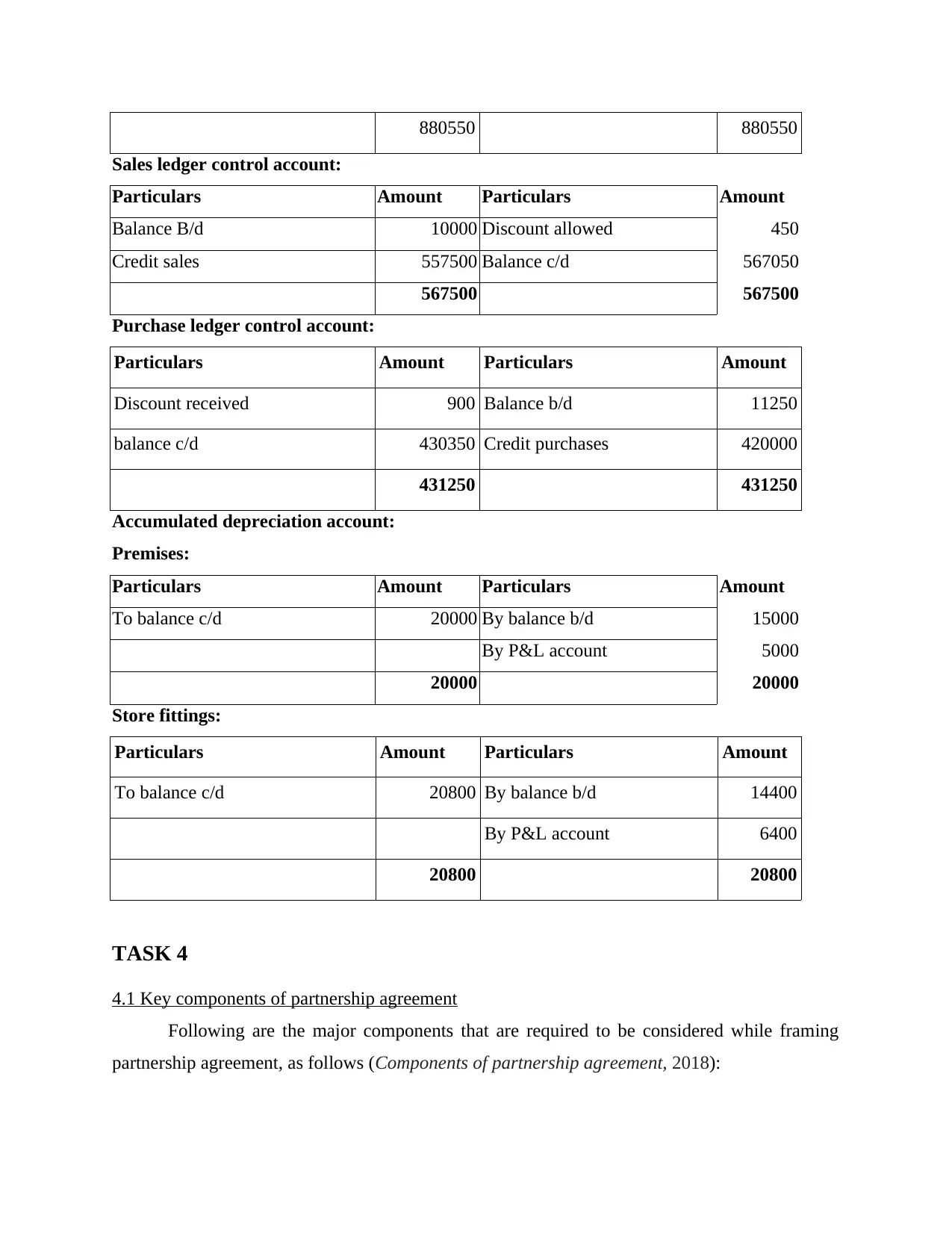
880550 880550
Sales ledger control account:
Particulars Amount Particulars Amount
Balance B/d 10000 Discount allowed 450
Credit sales 557500 Balance c/d 567050
567500 567500
Purchase ledger control account:
Particulars Amount Particulars Amount
Discount received 900 Balance b/d 11250
balance c/d 430350 Credit purchases 420000
431250 431250
Accumulated depreciation account:
Premises:
Particulars Amount Particulars Amount
To balance c/d 20000 By balance b/d 15000
By P&L account 5000
20000 20000
Store fittings:
Particulars Amount Particulars Amount
To balance c/d 20800 By balance b/d 14400
By P&L account 6400
20800 20800
TASK 4
4.1 Key components of partnership agreement
Following are the major components that are required to be considered while framing
partnership agreement, as follows (Components of partnership agreement, 2018):
Sales ledger control account:
Particulars Amount Particulars Amount
Balance B/d 10000 Discount allowed 450
Credit sales 557500 Balance c/d 567050
567500 567500
Purchase ledger control account:
Particulars Amount Particulars Amount
Discount received 900 Balance b/d 11250
balance c/d 430350 Credit purchases 420000
431250 431250
Accumulated depreciation account:
Premises:
Particulars Amount Particulars Amount
To balance c/d 20000 By balance b/d 15000
By P&L account 5000
20000 20000
Store fittings:
Particulars Amount Particulars Amount
To balance c/d 20800 By balance b/d 14400
By P&L account 6400
20800 20800
TASK 4
4.1 Key components of partnership agreement
Following are the major components that are required to be considered while framing
partnership agreement, as follows (Components of partnership agreement, 2018):
⊘ This is a preview!⊘
Do you want full access?
Subscribe today to unlock all pages.

Trusted by 1+ million students worldwide
1 out of 17
Related Documents
Your All-in-One AI-Powered Toolkit for Academic Success.
+13062052269
info@desklib.com
Available 24*7 on WhatsApp / Email
![[object Object]](/_next/static/media/star-bottom.7253800d.svg)
Unlock your academic potential
Copyright © 2020–2025 A2Z Services. All Rights Reserved. Developed and managed by ZUCOL.





